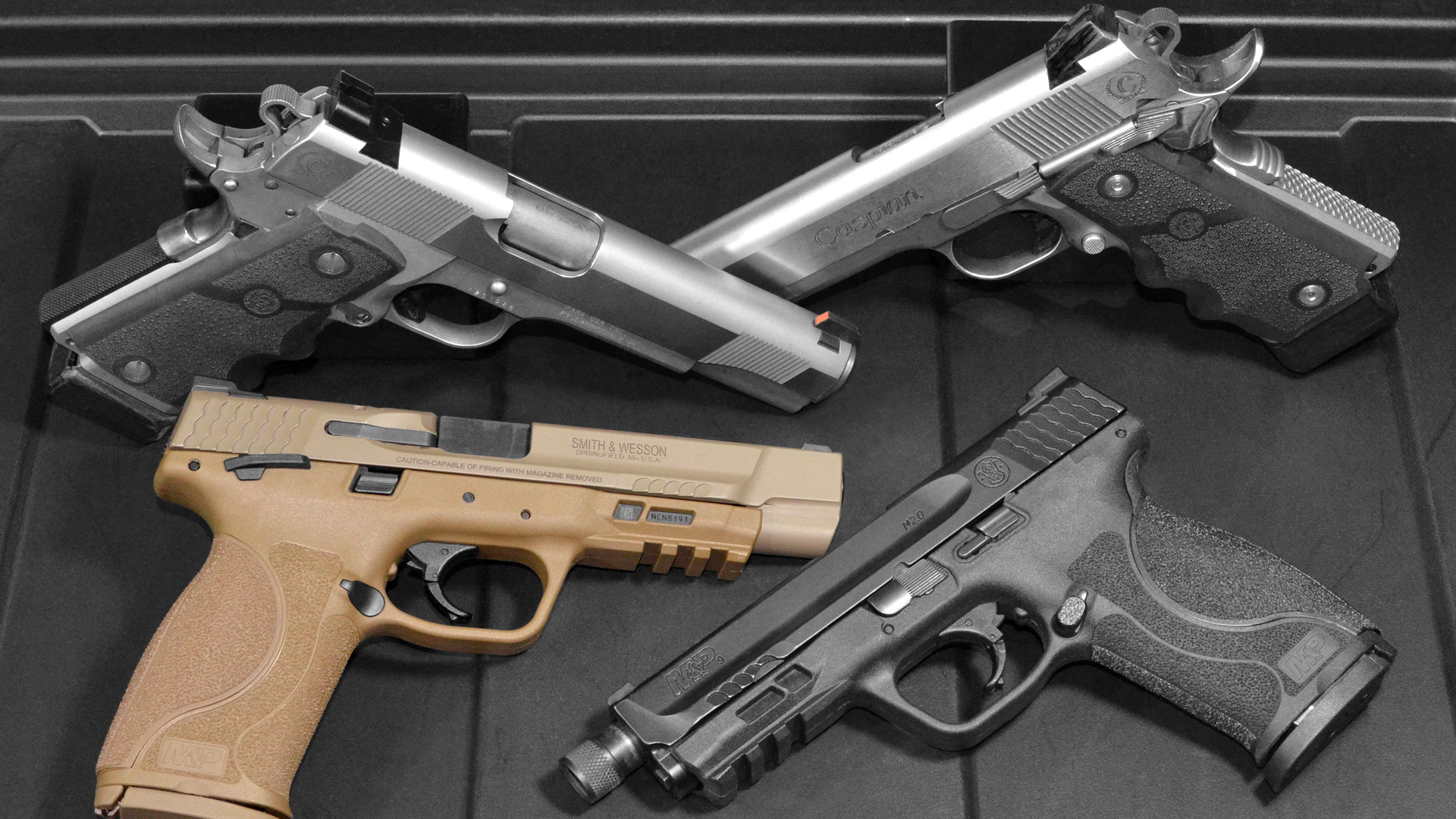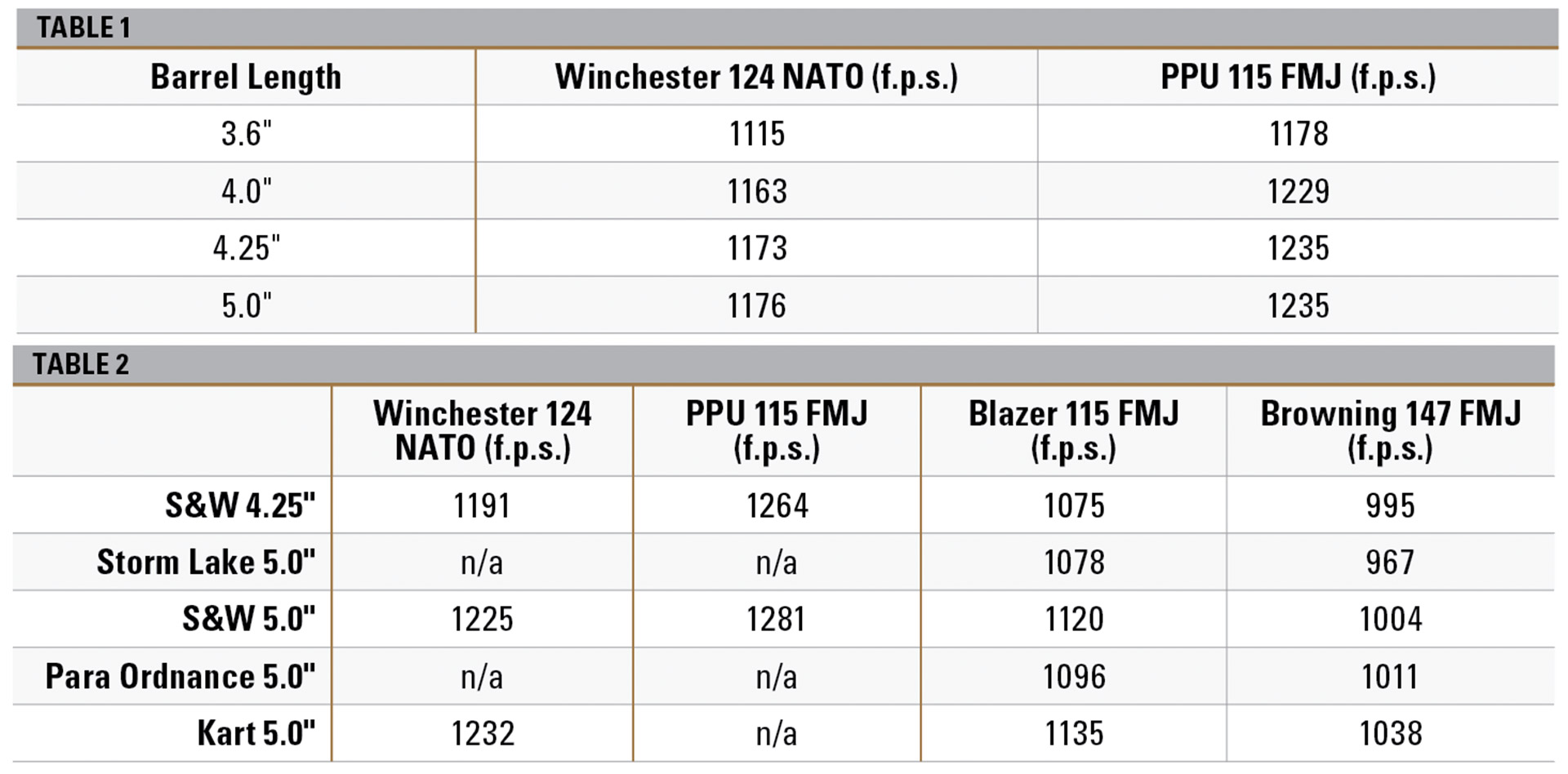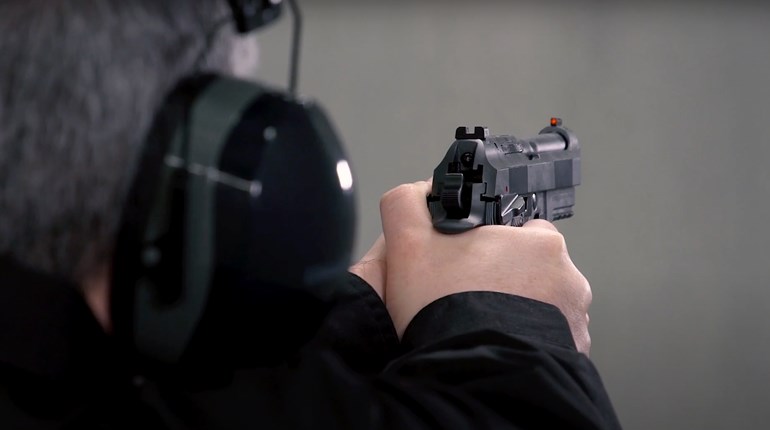
We know that barrel length affects velocity. Longer barrels produce higher speeds. That’s true for handguns, rifles and shotguns. There are limits to this rule, and if a barrel is really long, the bullet can start to slow down before it exits. Here, let’s keep our minds on typical barrel lengths.
It’s also true that different guns with the same barrel length can produce different velocities with the same ammunition because of differences in chamber dimensions and other specifications. When you toss that into the mix, velocities can vary in unexpected ways, like shorter barrels producing higher speeds than longer barrels.

I tested ammunition in four different guns with different barrel lengths to see what kind of speeds they produced. I tried to make it a “fair” comparison and used guns made by the same manufacturer. The guns were Smith & Wesson M&P 2.0 9 mm pistols. Barrel lengths were 3.6, 4.0, 4.25 and 5.0 inches. The general rule of thumb is that one inch of barrel length will change velocity by about 50 f.p.s. This is not written in stone, it’s just a general guide.
Results are from two different 9 mm rounds: Winchester NATO 124-grain FMJ and PPU NATO 115-grain FMJ. This data was collected during the same shooting session.
Results were mostly what one would expect, longer barrels produced more velocity, with the exception being the 5-inch barrel. It produced very little to no increase in speed over the 4.25-inch barrel.
An average increase of 49.5 f.p.s. was made with an increase of 0.4-inch barrel length, going from the shortest 3.6-inch barrel to the 4-inch barrel. There was a modest average increase of eight f.p.s. with a 0.25-inch increase in barrel length between the 4.0- and 4.25-inch barrels.
My M&P 5-inch barrel produced only a three f.p.s. increase of speed over the 4.25-inch barrel with the Winchester ammunition and no increase in speed at all with the PPU ammunition. Why? There are a couple of possible explanations. The most obvious explanation is that some barrels are slower or faster than others. Thus, our assumption that a longer barrel will produce more speed is simply wrong in this case. Variations in barrels can, and do, result in different speeds. In this case, the extra 0.75-inch of the 5-inch barrel did not result in more speed. Maybe the 4.25-inch barrel is unusually fast. Perhaps, but it barely produced much more speed than the 4-inch barrel. Maybe the 4-inch barrel is unusually fast, too.
Another possibility is that the powders were optimally designed for short barrels. Maybe, but it would be unlikely that we would see such a lack of velocity increase in barrels of these lengths. Five inches is not a long barrel for 9 mm, so I wouldn’t expect any gunpowder to make that kind of difference with this ammunition.
I did another test to see if the 5-inch barrel was to blame for the low speed. This time I included some other 5-inch barrels to see if the S&W M&P barrel was a slow barrel. I had some ammo left over from the first test: Winchester 124-grain 9 mm NATO and 10 rounds of PPU 115-grain NATO. And I grabbed a couple other boxes: Blazer 115-grain FMJ and Browning 147-grain FMJ.

The first shooting session was in July and the ambient temperate was 96˚ F. The second session (5-inch barrels) was run in January and the ambient temperature was 46˚ F. Another detail is that I might have used different chronographs for these sessions. I say might because, well, chronographs are fickle.
With the Winchester 9 mm NATO ammo, the 5-inch M&P barrel was now 34 f.p.s. faster than the 4.25-inch M&P barrel. It was only three f.p.s. faster in the first comparison. With the PPU ammunition, the two barrels produced the same speed in the first comparison, but now the 5-inch barrel was 17 f.p.s. faster. Why? The temperature was different between these shooting sessions. Some powders can be temperature sensitive, producing different results in cold and hot environments. Might this be why the 5-inch barrel produced higher speed this time? Maybe. It might have affected burning rate or efficiency that made it work better in a longer barrel whereas it didn’t before. But this is speculation.
Recorded velocities with the same ammunition during the second session with these barrels were faster than the velocities from the first session. Was this also due to the colder temperature? I can’t say because I might not have used the same chronograph for both sessions. Different chronographs can show different speeds, but that is a discussion for another time.
The results with four different 5-inch barrels were interesting. I also included the 4.25-inch M&P barrel with this test because I knew that one of the 5-inch barrels was a little slow from previous data, and I wanted to see how it compared to a shorter barrel. The 5-inch Kart and Para Ordnance barrels were in wide body Para Ordnance pistols with a Caspian slide.
First, I also fired the Winchester NATO round in the 5-inch Kart barrel. Its speed was only seven f.p.s. faster in the Kart barrel than in the M&P barrel, suggesting that the M&P barrel was not unusually slow.
The 5-inch Kart barrel produced the fastest speeds with the three loads tested. The second-fastest 5-inch barrel with the Blazer and Browning ammunition varied. The M&P barrel turned in the second-fastest speed with the Blazer 115-grain, but the Para Ordnance barrel won second place with the Browning 147-grain.
One 5-inch barrel was consistently the slowest—the Storm Lake barrel. This barrel is an extended, threaded barrel designed for the 4.25-inch M&P pistol. It measures 4.96 inches long, but I round it up to 5 inches because it’s so close. The difference in speed from the slowest (Storm Lake) and fastest (Kart) 5-inch barrels was 57 f.p.s. for the Blazer 115-grain and 71 f.p.s. for the Browning 147-grain. That’s quite a bit of difference, and is roughly what one might expect the difference to be between barrels that are only an inch different in length. We see here that barrels of the same length can produce significantly different speeds with the same ammunition.
Storm Lake’s 5-inch barrel speed is more like the 4.25-inch M&P barrel. With the Blazer ammo, the Storm Lake barrel was just three f.p.s. faster than the 4.25-inch M&P barrel. With the Browning ammo, the Storm Lake barrel was 28 f.p.s. slower than the 4.25-inch M&P barrel. I confess that I was skeptical of the results with the Browning 147-grain ammunition. So, I made a third trip to the range to test these two barrels with more Browning ammo. This time the ambient temperature was 50˚ F. The results confirmed that the 4.25-inch M&P barrel was faster than the 5-inch Storm Lake barrel. This time the 4.25-inch barrel was 35 f.p.s. faster than the 5-inch barrel (10 shots per barrel). Here again we see that you can’t always assume that a longer barrel means higher speed.

Conclusion
There are three lessons here. First, generally speaking, velocity will increase with barrel length, but not always. Sometimes a shorter barrel will produce higher speed than the longer barrel. Second, you can get significantly different speeds with barrels of the same length. Some barrels are slow or fast, depending on your perspective. Third, temperature might affect barrel length performance due to some powders’ temperature sensitive nature. It might have here.
There you have it. Barrel length affects velocity, but it depends on the barrel, the ammunition and maybe the temperature. The real world is full of surprises.
Read more: 4 Key Things To Do Before Your First Match


































